From the women’s competition at the 1964 Tokyo Olympics, we head to the men’s competition.
Spoiler alert: Once again, there was a big judging controversy that sparked debate about abandoning the 10.0.
This post is a long one, so here are some links to help you jump around.
Historical Context | Gymnastics Context | Judging Context | Video Footage | Team | All-Around | Event Finals | Judging Controversy | Judging Assignments | Math Gym Nerdery
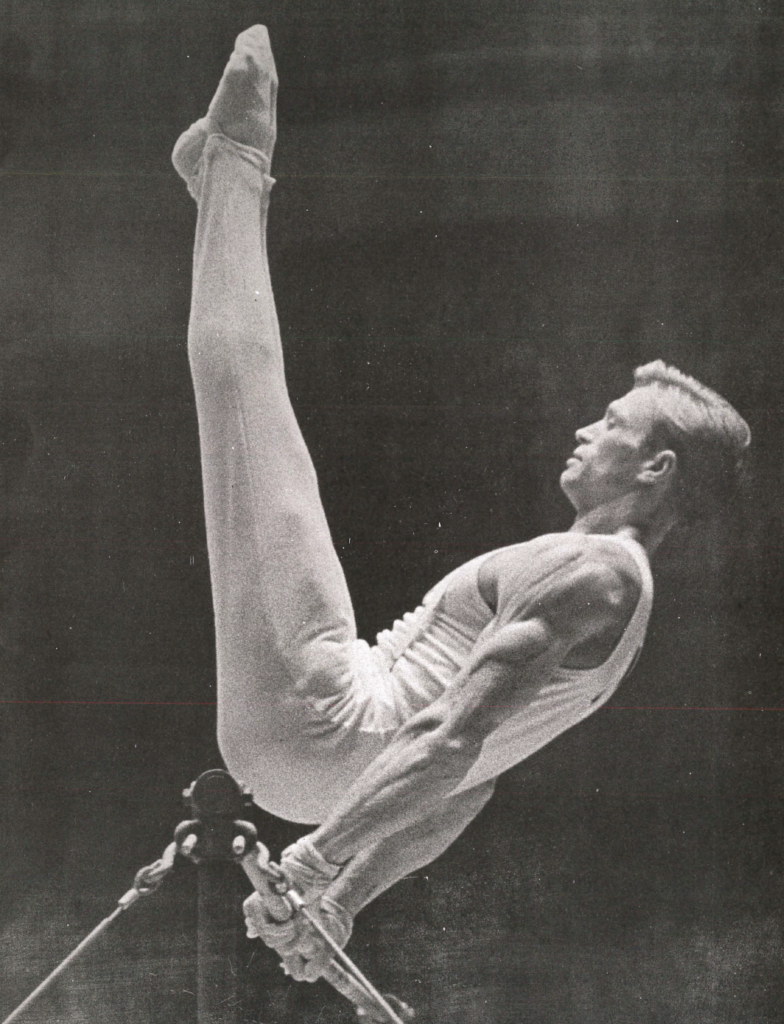
Compulsories: Sunday, October 18
Optionals: Tuesday, October 20
Event Finals: Thursday, October 22; Friday, October 23
Number of Male Athletes: 130
Youngest Male: Makoto Sakamoto (17, USA)
Oldest Male: Josy Stoffel (36, LUX)
Tallest: Frederick Trainer (6’, AUS)
Type of Equipment: Nissen-Senoh
Photo: Boris Shakhlin, Modern Gymnast, January, 1965
Historical Context
Gymnastics doesn’t happen in a vacuum. So, here’s some information to get you situated.
- Winter Olympics
- The Winter Olympics were held in Innsbruck, Austria earlier in the year.
- The 1994 Winter Olympics in Lillehammer, Norway were the first Winter Olympics to be held in a different year from the Summer Olympics.
- Japan
- Japan was on a growth trajectory. In 1960, Prime Minister Hayato Ikeda challenged the country to double its income in the next decade
- The Shinkansen, a high-speed rail system between Tokyo and Osaka, was inaugurated on October 1, 1964, just in time for the Olympics.
- Soviet Union
- Just before the start of the gymnastics competition, on October 14, 1964, Nikita Krushchev was stripped of his power.
- He was replaced by Leonid Brezhnev.
- Germany
- In 1961, the Berlin Wall was constructed, separating East and West Germany.
- Nevertheless, the two Germanies competed together at the Tokyo Olympics.
- Italy
- Italy was experiencing its “economic miracle.” The country’s GDP grew by 5.8% annually between 1951 and 1963, coinciding with the country’s rapid industrialization.
- Flooding from the Vajont Dam in Northern Italy destroyed several villages and killed roughly 2,000 people.
- Poland
- In 1956, more than 50 people were killed in rioting in Poznań over demands for greater freedom.
- Also, in 1956, Polish leader Gomułka aligned the country with the Soviet Union, saying, “Poland needs friendship with the Soviet Union more than the Soviet Union needs friendship with Poland… Without the Soviet Union we cannot maintain our borders with the West.”
- United States
- President Lyndon Johnson signed the Civil Rights Act on July 2, 1964, which prohibited discrimination on the basis of race, sex, color, religion, or national origin.
- Surgeon General Luther Terry reported that smoking might be hazardous to one’s health. (There was an article about the dangers of smoking in Modern Gymnast.)
- The Vietnam War and Cold War raged on.
Not your type of history? No problem. Here is some more information. In 1964…
- Roald Dahl’s Charlie and the Chocolate Factory was published.
- The Beatles’ “I Want to Hold Your Hand” was the number one song.
- The Ford Mustang was officially unveiled to the public.
Gymnastics Context
Here’s what was happening in the world of gymnastics…
- Japan had won the Olympic title in 1960 and World title in 1962.
- Boris Shakhlin (“Iron Man”) was the reigning Olympic all-around champion (1960).
- Yuri Titov was the reigning World all-around champion (1962)
- Leading up to Tokyo, he wasn’t competing much. After the Prague World Championships, he was “devoted to finishing his studies” (Modern Gymnast, April 1964).
- In April of 1964, he finished fifth (57.25) in the all-around during a dual meet with France. Lisitsky (58.30), Kerdemelidi (57.95), Tsapenko (57.65), and Gramow (57.40) beat him.
- Miroslav Cerar was the reigning European all-around champion (1963). He beat Shakhlin and Kerdemelidi.
- The Eastern Bloc didn’t participate in the women’s European Championships, but they did participate in the men’s Euros.
- The men’s European Championships were held in Serbia, part of the Eastern Bloc, so countries like the USSR didn’t withdraw from the men’s competition.
- Heading into the competition, Endo Yukio was favored to win.
- A Swiss publication said: “Strength, endurance, nerves of steel, flexibility, daring, and elegance are combined to an extent not found in any other individual. At the present time he is without a doubt, the world’s best gymnast.” (Modern Gymnast, April 1964)
- He finished second to Tsurumi in a dual between Japan and Hungary in April of 1964. But he was back on top at the Japanese Olympic Trials.
- The People’s Republic of China did not participate in the 1964 Olympic Games because of the IOC’s recognition of the Republic of China (Taiwan). (You can read the official statement from the Chinese Gymnastics Association here.)
- The FIG adopted its own anti-discriminatory statute. At the 1964 FIG Congress, the Congress forbid, within the FIG, the discrimination towards a country for political, religious, and racial motives (100 Years of the FIG).
- Politics and gymnastics intersect: At the 1964 FIG Congress, countries reported that visa issues prevented many of them from organizing international events.
- The first international course for judges was held in Zurich after the 43rd Congress. 53 brevet judges were certified for the men. (12 were certified for the women.)
- High score of the meet: 9.9 — Endo on parallel bars in finals
- Months later, in June of 1965, Medvedev scored a 10.0 on parallel bars at the USSR National Championships in Khabarovsk (Modern Gymnast, Sept/Oct. 1965).
Need to refresh your memory about what happened at the 1962 World Championships? No problem. Here’s a quick recap.
Judging Context
What’s that? You weren’t alive in 1964? Don’t worry, I wasn’t either. I’ve uploaded the entire men’s 1964 Code of Points here.
To refresh your memory, here are the skills the judges were looking for on each event:
Floor
- Use of the entire area without “too many” running steps
- No less than 50 seconds and no more than 70 seconds
- Movements must include elements of:
- Agility (Shifts in different directions)
- Balance
- Strength
- Flexibility
- Tumbling
- No abusive repetitions
Pommel Horse
- Continuous swinging work without holds or stops
- Use of the three parts: neck, croup, and saddle
- Scissors:
- Regular and reverse
- At least one performed twice in a row
- Circles with two legs must predominate the exercise
- Note: It was no longer required to circle in both directions for optional routines, but bidirectional circles could be required in compulsories.
- My thoughts: Making gymnasts circle in both directions in competition is just cruel. That’s like asking gymnasts to twist in both directions in a routine.
Rings
- No swing of the rings
- At least two (2) handstands
- One (1) executed through strength
- One (1) executed after passing through a hang or semi-inverted position
- At least one (1) strength move. Examples:
- Crosses
- Levers
- Planches
- All holds must be for three (3) seconds
Parallel Bars
- A combination of swinging, vaulting, strength, and hold elements
- Swinging and vaulting elements to predominate
- No more than three (3) hold positions
- At least one (1) movement of strength
- At least one release (B value) above the bars
- At least one release (B value) below the bars
High Bar
- Swinging without hold or pause
- Giant swing changes and turning moves
- And other connecting movements of high value (e.g. releases)
My Thought Bubble: You can see how the Code of Points was requiring more and more specificity, but the specificity was uneven across the events. The rings and parallel bars requirements are far more specific than the high bar requirements, for example.
As we’ll see in later codes, more clarity would be needed as time went by. Now, we have a 150+ page Code of Points written in 8-point font.
My Thought Bubble #2: Judges were asked to do a lot in 1964. Judges were scoring on a scale of 0 to 10 with one-tenth deductions. That meant that they had 101 possible scores that they could give out to 130 athletes.
During compulsories and optionals, their scores were supposed to reflect the difficulty, combination, and execution at the same time their scores were supposed to:
- Determine the rank of the teams
- Determine the rank of the gymnasts in the all-around
- Identify the top 6 athletes
And they were supposed to score rapidly. They were supposed to judge an entire men’s meet in 90 minutes. That’s a quick turnaround time.
Video Footage
God bless YouTube. We have one whole hour of coverage from the 1964 Tokyo Olympics. By the end of the hour, you will believe that you can speak another language fluently.
Unfortunately, the video doesn’t include a lower third with the gymnasts’ names. (Though, the commentator does mention the majority of the gymnasts’ names.) So, here’s a quick key to get you started.
Compulsories
- 0:00: Yuri Tsapenko, URS, PH, 9.55
- 0:42: Tsurumi Shuji, JPN, SR, 9.70
- 2:21: Endo Yukio, JPN, SR, 9.80
- 3:57: Yuri Titov, URS, SR, 9.600
- 6:13: Boris Shakhlin, URS, SR, 9.70
Optionals
- 7:59: Yamashita Haruhiro, JPN, FX, 9.60
- 9:47: Tsurumi Shuji, JPN, FX, 9.60
- 11:41: Mitsukuri Takashi, JPN, FX, 9.60
- 12:56: Endo Yukio, JPN, FX, 9.75
- 14:45: Boris Shakhlin, URS, HB, 9.80
- 15:49: Tsurumi Shuji, JPN, PH, 9.70
- 17:05: Endo Yukio, JPN, PH, 9.10
- 19:19: Viktor Lisitsky, URS, FX, 9.70
- 21:43: Mitsukuri Takashi, JPN, PH, 9.65
- 22:54: Franco Menichelli, ITA, FX, 9.70
Event Finals
- 25:14: Franco Menichelli, ITA, FX, 9.80 (19.45)
- 28:34: Yamashita Haruhiro, VT, 9.85 (19.60)
- 29:10: Franco Menichelli, ITA, PB, 9.70 (19.35)
- 30:03: Miroslav Cerar, YUG, PB, 8.70 (18.45)
- 31:11: Tsurumi Shuji, JPN, PB, 9.70 (19.45)
- 32:50: Viktor Lisitsky, URS, PB, 9.45 (19.20)
- 34:03: Endo Yukio, JPN, PB, 9.90 (19.675)
- 36:45: Tsurumi Shuji, JPN, SR, 9.60 (19.275)
- 38:31: Viktor Leontiev, URS, SR, 9.70 (19.35)
- 40:50: Boris Shakhlin, URS, SR, 9.750 (19.40)
- 42:34: Franco Menichelli, URS, SR, 9.70 (19.425)
- 44:44: Endo Yukio, JPN, SR, 9.50 (19.250)
- 46:25: Yamashita Haruhiro, JPN, PH, 9.50 (19.075)
- 48:25: Yuri Tsapenko, URS, PH, 9.65 (19.20)
- 50:41: Harald Wigaard, NOR, PH, 9.40 (18.925)
- 52:11: Mistukuri Takashi, JPN, PH, 9.00 (18.650)
- 53:51: Miroslav Cerar, YUG, PH, 9.80 (19.525)
- 55:22: Tsurumi Shuji, JPN, PH, 9.70 (19.325)
- 57:46: Ono Takashi, JPN, HB, 9.30 (19.000)
- 59:59: Miroslav Cerar, YUG, HB, 9.85 (19.500)
- 1:02:01: Yuri Titov, URS, HB, 9.80 (19.55)
- 1:04:24: Boris Shakhlin, URS, HB, 9.85 (19.625)
- 1:06:33: Endo Yukio, JPN, HB, 9.35 (19.050)
Endo Yukio on PH (17:05): This was the routine that upset a murder of gym fans. We’ll discuss this more in the “Judging Controversy” section.
Franco Menichelli on FX (22:54 and 25:14): Before there were hot pants in the 1970s, there were men’s FX shorts in the 1960s.
Anyway, notice the changes in rhythm. His routine accelerates with his cartwheel layout stepout and his back handspring series into an Arabian back handspring (called an “Onodi” today) before slowing down again in the splits. This is what the judges were looking for.
And notice the amplitude on every single skill — from the lift on the layout full to the height on the back handspring stepouts.
Tsurumi Shuji on PB (31:11): Originality was important back in the day, and every gymnast was looking for their signature skill that would set him apart. Tsurumi’s was the one-armed handstand on parallel bars. While the skill didn’t represent the future of single-rail work, it’s a fun relic of the past.
Viktor Lisitsky on PB (32:50): Speaking of relics of the past, it’s fun watching these old routines because you see skills that you’d never see nowadays. Lisitsky brings pommel horse to the parallel bars. (Circles on parallel bars are still in the Code of points. A single circle is an A in the 2017-2020 Code.)
Tsurumi Shuji (36:45) vs. Viktor Leontiev (38:31): Both of these gymnasts showed where rings were heading — inverted crosses and double back dismounts.
Since double back dismounts were relatively new, it’s interesting to compare their technique. Tsurumi hung onto the rings for much longer–almost like a modern-day Guczoghy. Leontiev let go much earlier, using a technique that became the standard because it allowed for twisting double backs.
Ono Takashi on HB (57:46): It’s easy to write off these routines as easy, but Ono did an Adler/Tak 1/1 to mixed grip, which in the 2017-2020 Code is a D. He also performed his eponymous skill at the 58:04 mark.
An Aside: It’s also fun to watch them haul out the ladder and adjust the chalk on the high bar between turns.
Endo Yukio on HB (1:06:33): While we are calling out eponymous skills, we have to take notice of the inventor of the Endo (1:07:01). If you don’t know what an Endo is, think of it as a forward Stalder.
Not Featured: The First Double Back at the Olympics: According to Modern Gymnast, Rusty Mitchell of the USA “did a double back sommi mount, the first in Olympic history, and stuck it solid.”
It’s unclear if it actually was the first double back on floor at the Olympics. The US Gymnastics Hall of Fame website says: “It may have been the first double-back to be used in Olympic FX competition.”
At the 1962 World Championships, Hristov attempted a double back but missed it in competition.
Team Competition
Reminder: Teams consisted of 6 members. The best 5 scores on each event counted for both compulsories and optionals. While gymnasts were performing their compulsory and optional routines, they were competing for the team and all-around title, as well as vying for places in the event finals.
Here were the groupings for compulsories:
- Group A (8:30 am / 5:00 pm)
- Korea (Floor)
- Yugoslavia (Pommel Horse)
- Czechoslovakia (Rings)
- Italy (Vault)
- Mongolia, Norway, Sweden (High Bar)
- Group B (10 am / 6:30 pm)
- Taiwan (Floor)
- Poland (Pommel Horse)
- Iran, Great Britain, Philippines (Rings)
- Finland (Vault)
- USA (Parallel Bars)
- Canada (High Bar)
- Group C (11:30 am / 8:00 pm)
- Australia (Floor)
- France, Luxembourg (Pommel Horse)
- Hungary (Rings)
- India (Vault)
- Germany (Parallel Bars)
- Switzerland (High Bar)
- Group D (1 pm / 9:00 pm)
- Algeria, Argentina, United Arab Republic (Floor)
- USSR (Pommel Horse)
- Japan (Rings)
- Romania (Vault)
- Bulgaria (Parallel Bars)
- Cuba (High Bar)
Each group had a mixed group with individual athletes, and the men’s compulsories were split between morning and night sessions. The last rotation was scheduled to start at 10:30 pm.
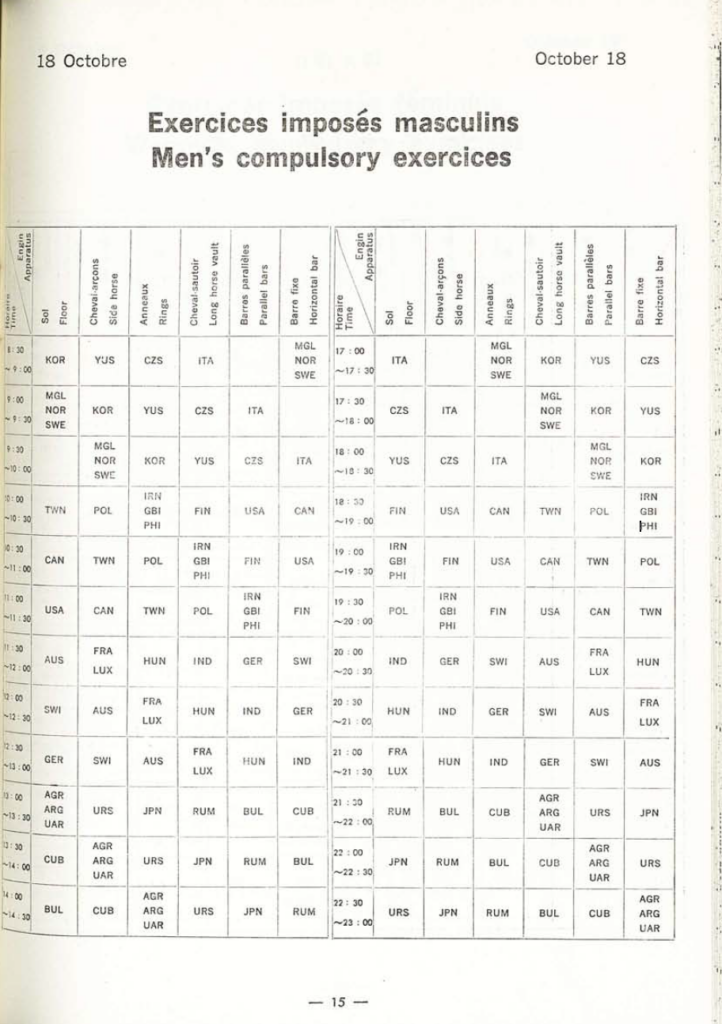
The split schedule occurred during optionals, as well. The groupings were the same, but the timetables changed.
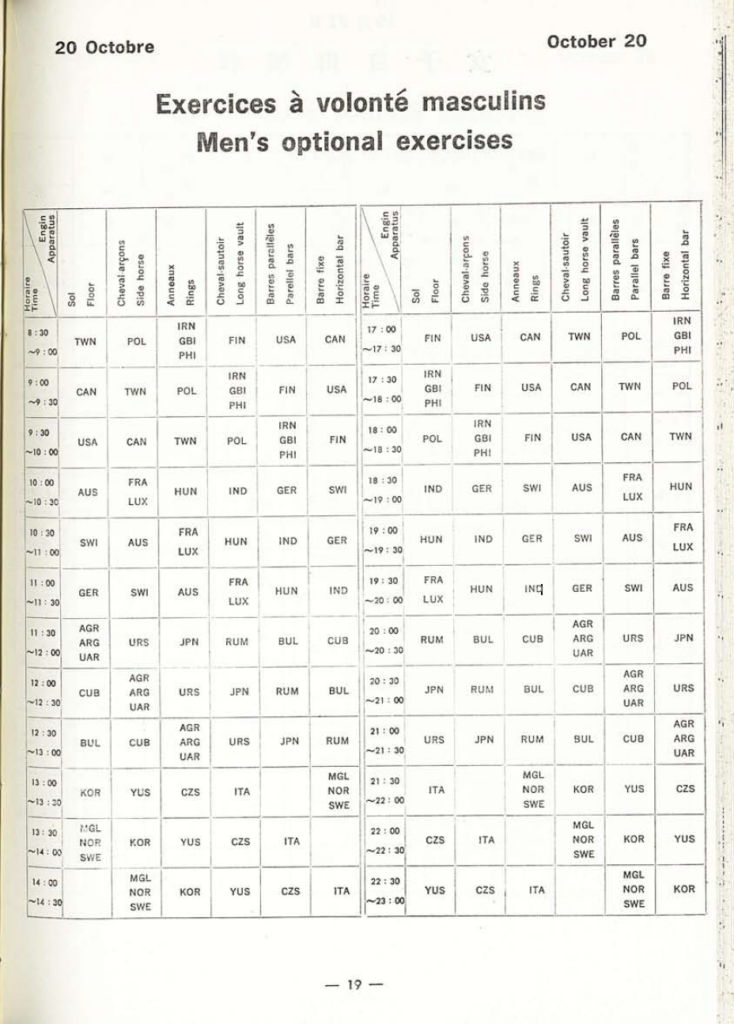
Ouchie Wowwa: Ono was competing with a separated shoulder (Modern Gymnast, Dec. 1964).
Anyway, after compulsories, here were the standings.
| Country | Compulsory Score | Final Ranking |
| 1. Japan | 289.00 | 1 |
| 2. Soviet Union | 287.55 | 2 |
| 3. Germany | 280.70 | 3 |
| 4. Poland | 280.60 | 5 |
| 5. Italy | 278.70 | 4 |
| 6. Hungary | 278.45 | 9 |
| 7. United States | 277.60 | 7 |
| 8. Finland | 277.00 | 8 |
| 9. Czechoslovakia | 276.90 | 6 |
| 10. Yugoslavia | 276.55 | 11 |
| 11. Bulgaria | 276.50 | 10 |
| 12. Korea | 274.05 | 13 |
| 13. Romania | 273.65 | 12 |
| 14. Switzerland | 271.75 | 14 |
| 15. Cuba | 260.60 | 15 |
| 16. Australia | 253.45 | 16 |
| 17. Taiwan | 245.50 | 17 |
| 18. India | 213.15 | 18 |
Japan managed to extend its lead.
| FX | PH | SR | VT | PB | HB | Total | |
| 1. Japan | 577.95 | ||||||
| C. | 48.00 | 47.80 | 48.25 | 48.25 | 48.40 | 48.30 | 289.00 |
| O. | 48.10 | 47.90 | 48.15 | 48.35 | 48.35 | 48.10 | 288.95 |
| 2. USSR | 575.45 | ||||||
| C. | 47.85 | 47.20 | 47.90 | 48.15 | 48.25 | 48.20 | 287.55 |
| O. | 47.95 | 47.10 | 48.15 | 48.25 | 48.05 | 48.40 | 287.90 |
| 3. Germany | 565.10 | ||||||
| C. | 47.05 | 45.95 | 46.45 | 47.45 | 47.20 | 46.60 | 280.70 |
| O. | 47.15 | 47.05 | 47.35 | 48.05 | 47.55 | 47.25 | 284.40 |
| 4. Italy | 560.90 | ||||||
| C. | 45.95 | 46.00 | 46.60 | 46.40 | 47.50 | 46.25 | 278.70 |
| O. | 46.90 | 46.65 | 47.05 | 47.50 | 45.45 | 46.65 | 282.20 |
| 5. Poland | 559.50 | ||||||
| C. | 46.55 | 46.45 | 46.20 | 47.40 | 47.05 | 46.95 | 280.60 |
| O. | 47.10 | 44.65 | 46.35 | 47.20 | 46.30 | 47.30 | 278.90 |
| 6. Czechoslovakia | 558.15 | ||||||
| C. | 45.95 | 45.05 | 45.85 | 46.85 | 46.80 | 46.40 | 276.90 |
| O. | 46.50 | 46.55 | 46.60 | 47.80 | 47.15 | 46.65 | 281.25 |
| 7. United States | 556.95 | ||||||
| C. | 45.50 | 46.35 | 46.30 | 46.65 | 46.70 | 46.10 | 277.60 |
| O. | 46.80 | 46.00 | 46.70 | 47.55 | 46.10 | 46.20 | 279.35 |
| 8. Finland | 556.20 | ||||||
| C. | 46.60 | 46.50 | 44.35 | 47.15 | 46.30 | 46.10 | 277.00 |
| O. | 47.25 | 46.20 | 45.25 | 47.70 | 47.00 | 45.80 | 279.20 |
| 9. Hungary | 555.70 | ||||||
| C. | 46.35 | 45.60 | 45.70 | 47.05 | 46.80 | 46.95 | 278.45 |
| O. | 45.30 | 45.10 | 45.90 | 47.30 | 46.60 | 47.05 | 277.25 |
| 10. Bulgaria | 555.65 | ||||||
| C. | 45.20 | 45.80 | 45.40 | 46.95 | 46.25 | 46.90 | 276.50 |
| O. | 46.40 | 45.80 | 46.05 | 47.45 | 46.30 | 47.15 | 279.15 |
| 11. Yugoslavia | 554.80 | ||||||
| C. | 45.35 | 46.25 | 45.45 | 46.70 | 46.80 | 46.00 | 276.55 |
| O. | 45.35 | 46.20 | 46.25 | 47.15 | 46.50 | 46.80 | 278.25 |
| 12. Romania | 550.65 | ||||||
| C. | 45.95 | 45.50 | 44.50 | 46.55 | 46.25 | 44.90 | 273.65 |
| O. | 45.95 | 45.15 | 45.80 | 47.45 | 46.55 | 46.10 | 277.00 |
| 13. Korea | 549.50 | ||||||
| C. | 45.20 | 45.10 | 45.05 | 45.95 | 46.45 | 46.30 | 274.05 |
| O. | 46.45 | 44.90 | 44.55 | 47.00 | 46.00 | 46.55 | 275.45 |
| 14. Switzerland | 546.15 | ||||||
| C. | 45.30 | 45.75 | 42.15 | 47.30 | 46.65 | 44.60 | 271.75 |
| O. | 44.55 | 45.95 | 43.60 | 47.90 | 46.50 | 45.90 | 274.40 |
| 15. Cuba | 522.95 | ||||||
| C. | 44.75 | 42.60 | 41.45 | 45.95 | 43.85 | 42.00 | 260.60 |
| O. | 44.30 | 39.90 | 43.20 | 46.30 | 44.55 | 44.10 | 262.35 |
| 16. Australia | 512.00 | ||||||
| C. | 43.00 | 41.25 | 38.70 | 46.05 | 43.00 | 41.45 | 253.45 |
| C. | 43.20 | 41.55 | 40.75 | 45.65 | 44.55 | 42.85 | 258.55 |
| 17. Taiwan | 493.05 | ||||||
| C. | 42.35 | 32.15 | 40.60 | 45.40 | 42.75 | 42.25 | 245.50 |
| O. | 42.65 | 30.45 | 41.15 | 44.60 | 44.70 | 44.00 | 247.55 |
| 18. India | 428.35 | ||||||
| C. | 40.70 | 35.70 | 31.80 | 42.95 | 33.85 | 28.15 | 213.15 |
| O. | 40.10 | 30.50 | 36.45 | 43.75 | 37.25 | 27.15 | 215.20 |
A sad, but interesting tidbit: “Individuals of teams that finished first, second or third in the Team category for artistic gymnastics were awarded only a ‘diploma.’” Only one medal was given to each team.
Commentary from the Time
In December of 1964, the Modern Gymnast ran an article by U.S. gymnast Larry Banner. It gives us some additional perspective–at least an American perspective.
The top two teams ended up in the last group (Group D). Was it really a random draw?
There were doubts.
The beginning times for the various teams were, reportedly, determined by draw and would not, according to FIG regulations, affect the individual or team scores.
But, but, but: Though the FIG claimed that draws didn’t impact scores, Larry Banner wasn’t buying it. He believed that the judges got the team rank order correct. But they didn’t do a good job of ranking the individuals for event finals, especially those in earlier sessions.
- Because the judges were so focused on ranking the teams correctly, they reserved the high scores for the top teams in the final session and didn’t reward event specialists in earlier sessions.
- He believed that Canada’s Wilhelm Weiler belonged in the vault final, and Sweden’s Leif Koorn belonged in the rings final.
- He added: “Even though the winning teams are bound to have a majority of the individual medalists, no two teams in Tokyo had more than 3 men between them whose work warranted the final competition.”
My thought bubble: It’s hard to make a counter-argument without seeing all the routines. That said, Banner’s criticism doesn’t entirely hold up. Gymnasts from Yugoslavia, Norway, Italy, and Finland were able to make it to finals, but to Banner’s point, those gymnasts were anomalies.
Watch this space as we continue our journey through gymnastics history. Various forms of Banner’s argument will crop up, leading to ever-changing rules for event finals.
One more tidbit: Banner believed that Japan should have been further ahead, and the Soviet Union and Germany should have been closer.
The final scores do not reflect the propinquity between the German and Russian teams, but neither do they reflect the distance between the Japanese and Russian performances.
The All-Around
Reminder: There wasn’t a separate all-around competition as there is today. At the same time that gymnasts were competing for the team title, they were competing for the all-around title. Their all-around totals were the sum of their optional and compulsory routines.
Rankings after Compulsories – Top 10
| Gymnast | Comp. AA Score | Final AA Rank |
| 1. Endo | 58.30 | 1 |
| 2. Tsurumi | 57.80 | 2 |
| 3. Lisitsky | 57.65 | 2 |
| 4. Shakhlin | 57.60 | 2 |
| 4. Ono | 57.60 | 11 |
| 6. Titov | 57.50 | 13 |
| 7. Yamashita | 57.40 | 6 |
| 8. Mitsukuri | 57.40 | 9 |
| 9. Menichelli | 57.30 | 5 |
| 9. Cerar | 57.30 | 7 |
Heading into the optionals portion of the competition, Endo had a sizable lead of 0.5. He would maintain that lead throughout the optionals portion. Though, there were doubts about his pommel horse score. (More on that in the “Judging Controversy” section.)
Final Rankings – Top 20
| FX | PH | SR | VT | PB | HB | Total | |
| 1. Endo Yukio | JPN | 115.95 | |||||
| C. | 9.65 | 9.60 | 9.80 | 9.75 | 9.80 | 9.70 | 58.30 |
| O. | 9.75 | 9.10 | 9.70 | 9.65 | 9.75 | 9.70 | 57.65 |
| 2. Tsurumi Shuji | JPN | 115.40 | |||||
| C. | 9.50 | 9.55 | 9.70 | 9.65 | 9.75 | 9.65 | 57.80 |
| O. | 9.60 | 9.70 | 9.65 | 9.65 | 9.75 | 9.25 | 57.60 |
| 2. Shakhlin, Boris | URS | 115.40 | |||||
| C. | 9.45 | 9.45 | 9.70 | 9.65 | 9.60 | 9.75 | 57.60 |
| O. | 9.50 | 9.45 | 9.70 | 9.70 | 9.65 | 9.80 | 57.80 |
| 2. Lisitsky, Viktor | URS | ||||||
| C. | 9.60 | 9.35 | 9.50 | 9.75 | 9.80 | 9.65 | 57.65 |
| O. | 9.70 | 9.40 | 9.60 | 9.75 | 9.70 | 9.60 | 57.75 |
| 5. Menichelli, Franco | ITA | 115.15 | |||||
| C. | 9.60 | 9.40 | 9.65 | 9.35 | 9.70 | 9.60 | 57.30 |
| O. | 9.70 | 9.40 | 9.80 | 9.70 | 9.60 | 9.65 | 57.85 |
| 6. Yamashita Haruhiro | JPN | 115.10 | |||||
| C. | 9.55 | 9.50 | 9.35 | 9.70 | 9.65 | 9.65 | 57.40 |
| O. | 9.60 | 9.65 | 9.40 | 9.80 | 9.65 | 9.60 | 57.70 |
| 7. Cerar, Miroslav | YUG | 115.05 | |||||
| C. | 9.40 | 9.70 | 9.45 | 9.50 | 9.70 | 9.55 | 57.30 |
| O. | 9.25 | 9.75 | 9.60 | 9.60 | 9.80 | 9.75 | 57.75 |
| 8. Hayata Takuji | JPN | 114.90 | |||||
| C. | 9.60 | 9.40 | 9.70 | 9.45 | 9.45 | 9.60 | 57.20 |
| O. | 9.55 | 9.50 | 9.75 | 9.70 | 9.70 | 9.50 | 57.70 |
| 9. Mitsukuri Takashi | JPN | 114.80 | |||||
| C. | 9.60 | 9.65 | 9.50 | 9.50 | 9.60 | 9.55 | 57.40 |
| O. | 9.60 | 9.65 | 9.50 | 9.55 | 9.50 | 9.60 | 57.40 |
| 10. Leontiev, Viktor | URS | 114.50 | |||||
| C. | 9.55 | 9.40 | 9.70 | 9.40 | 9.60 | 9.50 | 57.15 |
| O. | 9.65 | 9.30 | 9.60 | 9.55 | 9.55 | 9.70 | 57.35 |
| 11. Ono Takashi | JPN | 114.40 | |||||
| C. | 9.60 | 9.50 | 9.55 | 9.65 | 9.60 | 9.70 | 57.60 |
| O. | 9.30 | 9.40 | 9.55 | 9.55 | 9.30 | 9.70 | 56.80 |
| 11. Tsapenko, Yuri | URS | 114.40 | |||||
| C. | 9.55 | 9.55 | 9.40 | 9.50 | 9.60 | 9.50 | 57.10 |
| O. | 9.65 | 9.55 | 9.60 | 9.55 | 9.45 | 9.50 | 57.30 |
| 13. Titov, Yuri | URS | 114.35 | |||||
| C. | 9.50 | 9.45 | 9.60 | 9.65 | 9.60 | 9.70 | 57.50 |
| O. | 9.20 | 9.15 | 9.65 | 9.60 | 9.45 | 9.80 | 56.85 |
| 14. Diomidov, Sergei | URS | 114.20 | |||||
| C. | 9.65 | 9.35 | 9.40 | 9.60 | 9.65 | 9.60 | 57.25 |
| O. | 9.45 | 9.40 | 9.45 | 9.65 | 9.70 | 9.30 | 56.95 |
| 15. Fülle, Siegfried | GER | 114.10 | |||||
| C. | 9.50 | 9.30 | 9.50 | 9.65 | 9.50 | 9.40 | 56.85 |
| O. | 9.50 | 9.50 | 9.55 | 9.65 | 9.50 | 9.55 | 57.25 |
| 16. Kubica, Mikołaj | POL | 113.20 | |||||
| C. | 9.35 | 9.50 | 9.35 | 9.55 | 9.60 | 9.50 | 56.85 |
| O. | 9.45 | 9.20 | 9.45 | 9.55 | 9.10 | 9.60 | 56.35 |
| 17. Csányi, Rajmund | HUN | 113.00 | |||||
| C. | 9.20 | 9.30 | 9.35 | 9.55 | 9.50 | 9.70 | 56.60 |
| O. | 9.30 | 9.25 | 9.25 | 9.55 | 9.50 | 9.55 | 56.40 |
| 18. Köste, Klaus | GER | 112.75 | |||||
| C. | 9.40 | 9.20 | 8.85 | 9.40 | 9.40 | 9.50 | 55.75 |
| O. | 9.55 | 9.35 | 9.40 | 9.70 | 9.60 | 9.40 | 57.00 |
| 19. Koppe, Erwin | GER | 112.45 | |||||
| C. | 9.15 | 9.20 | 9.25 | 9.40 | 9.50 | 9.30 | 55.80 |
| O. | 9.30 | 9.40 | 9.55 | 9.35 | 9.55 | 9.50 | 56.65 |
| 20. Sakamoto, Makoto | USA | 112.40 | |||||
| C. | 9.05 | 9.25 | 9.40 | 9.45 | 9.40 | 9.35 | 55.90 |
| O. | 9.35 | 9.25 | 9.40 | 9.50 | 9.50 | 9.50 | 56.50 |
Yes, all three silver medalists fit on the podium. I knew you were concerned. I was.
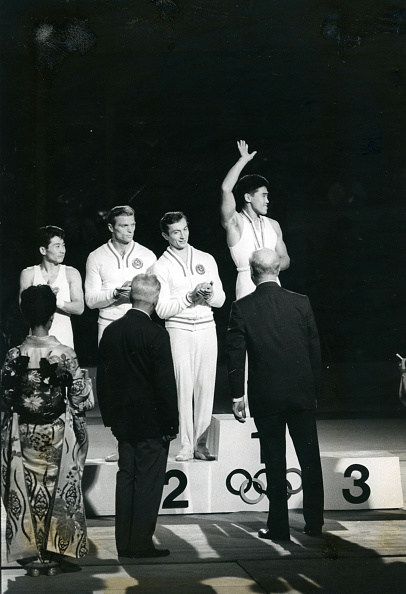
Event Finals
Reminder: Only six gymnasts qualified for event finals. Qualification for finals was based on the compulsory *and* optional scores on each event.
Your total score was the average of your compulsory and optional scores (labeled “COA” in the tables below) plus the score for your routine during event finals.
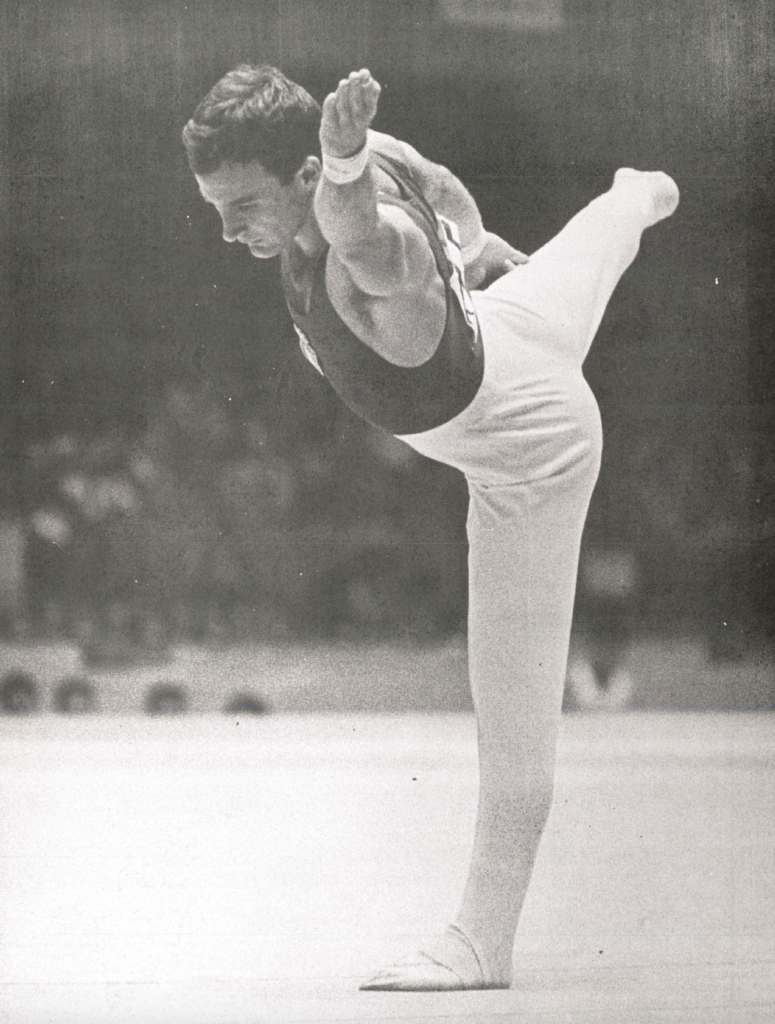
Floor Exercise
| Country | Finals | COA | Total | |
| 1. Menichelli, Franco | ITA | 9.80 | 9.650 | 19.450 |
| 2. Lisitsky, Viktor | URS | 9.70 | 9.650 | 19.350 |
| 2. Endo Yukio | JPN | 9.65 | 9.700 | 19.350 |
| 4. Leontiev, Viktor | URS | 9.60 | 9.600 | 19.200 |
| 5. Mitsukuri, Takashi | JPN | 9.50 | 9.600 | 19.100 |
| 6. Tsapenko, Yuri | URS | 9.25 | 9.600 | 18.850 |
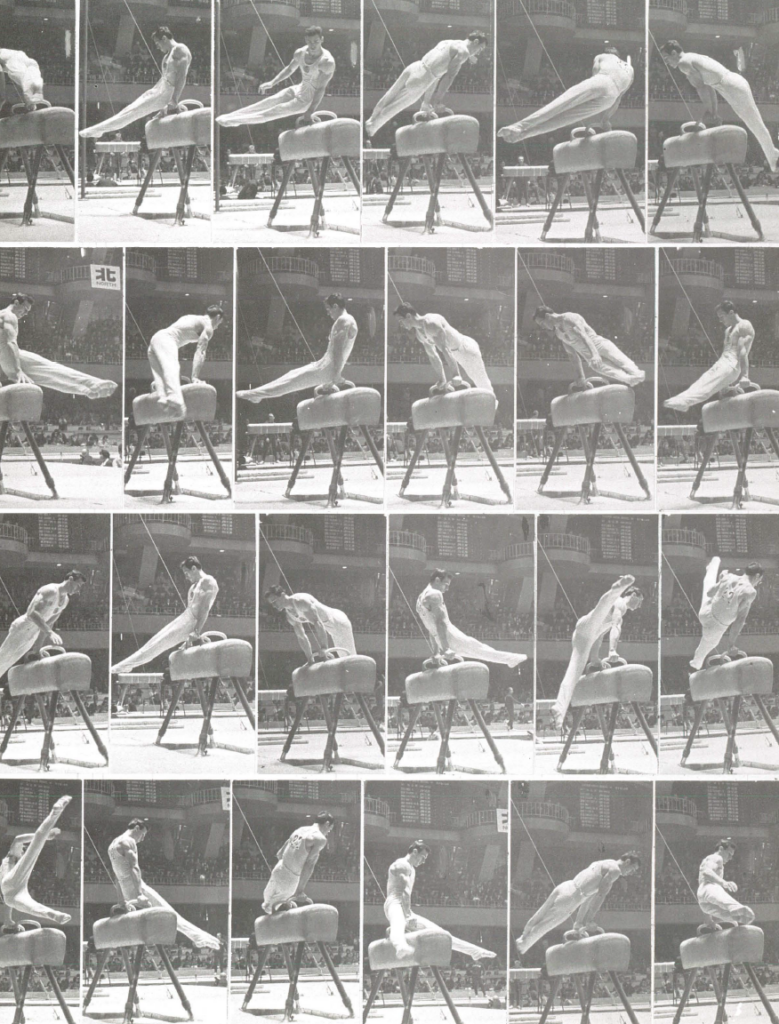
Pommel Horse
| Country | Finals | COA | Total | |
| 1. Cerar, Miroslav | YUG | 9.80 | 9.725 | 19.525 |
| 2. Tsurumi Shuji | JPN | 9.70 | 9.625 | 19.325 |
| 3. Tsapenko, Yuri | URS | 9.65 | 9.550 | 19.200 |
| 4. Yamashita Haruhiro | JPN | 9.50 | 9.575 | 19.075 |
| 5. Wigaard, Harald | NOR | 9.40 | 9.525 | 18.925 |
| 6. Mitsukuri Takashi | JPN | 9.00 | 9.650 | 18.650 |
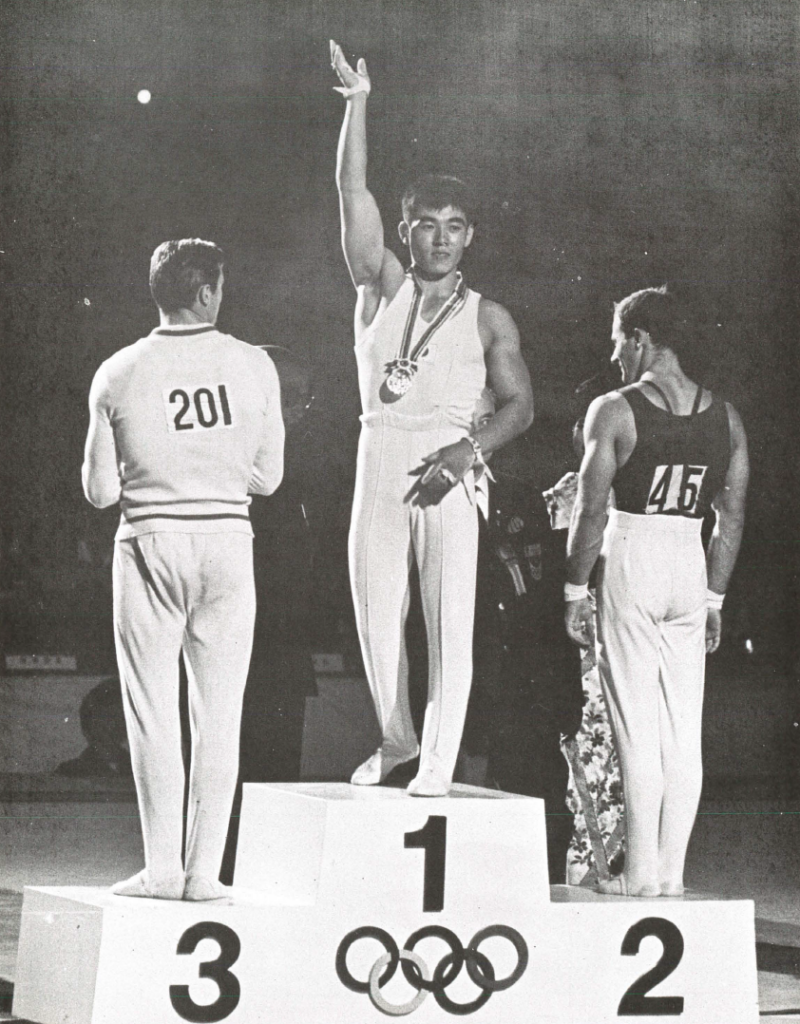
Still Rings
| Country | Finals | COA | Total | |
| 1. Hayata Takuji | JPN | 9.75 | 9.725 | 19.475 |
| 2. Menichelli, Franco | ITA | 9.70 | 9.725 | 19.425 |
| 3. Shakhlin, Boris | URS | 9.70 | 9.700 | 19.400 |
| 4. Leontiev, Viktor | URS | 9.70 | 9.650 | 19.350 |
| 5. Tsurumi Shuji | JPN | 9.60 | 9.675 | 19.275 |
| 6. Endo Yukio | JPN | 9.50 | 9.750 | 19.250 |
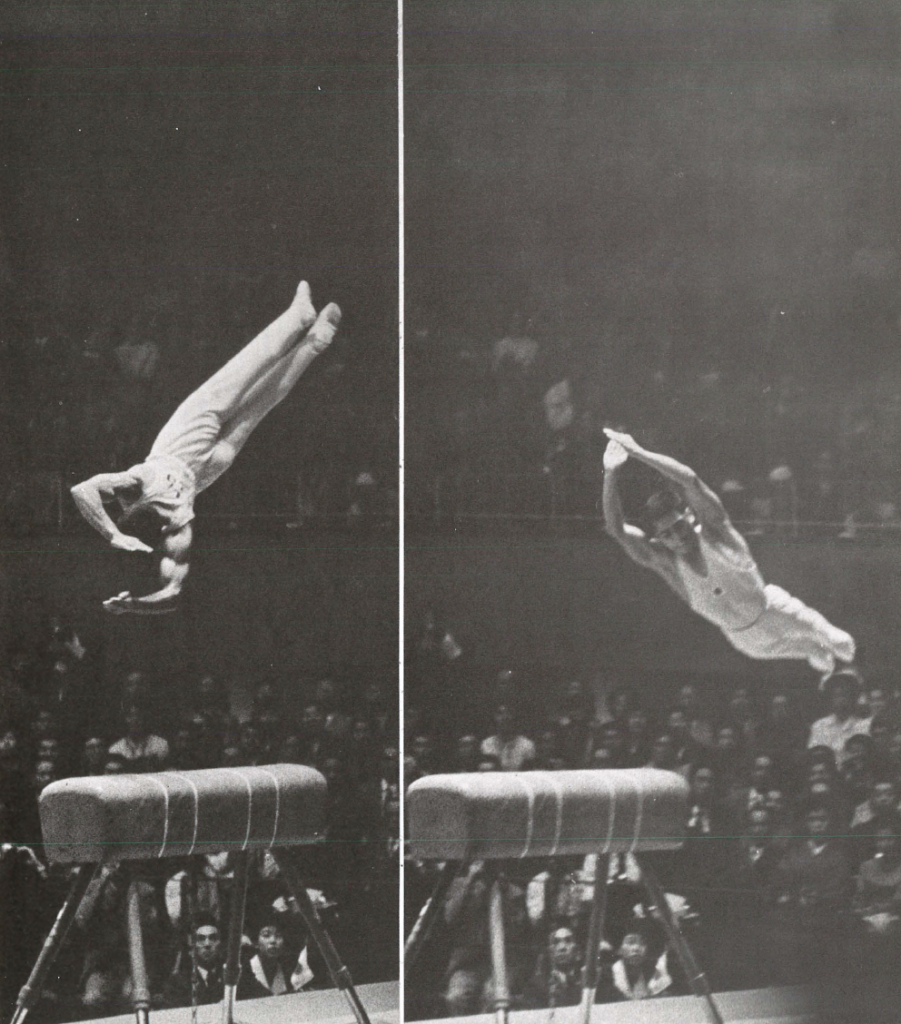
Vault
| Country | Finals | COA | Total | |
| 1. Yamashita Haruhiro | JPN | 9.850 | 9.750 | 19.600 |
| 2. Lisitsky, Viktor | URS | 9.575 | 9.750 | 19.325 |
| 3. Rantakari, Hannu | FIN | 9.625 | 9.675 | 19.300 |
| 4. Tsurumi Shuji | JPN | 9.575 | 9.650 | 19.225 |
| 5. Shakhlin, Boris | URS | 9.525 | 9.675 | 19.200 |
| 6. Endo Yukio | JPN | 9.375 | 9.700 | 19.075 |
Reminder: Gymnasts had to perform two different vaults in finals. Yamashita performed piked handspring from the croup and a full-twisting pike handspring from the croup (near end).
Endo Yukio had a wild vault final.
According to Banner in Modern Gymnast…
The first somersault was too strong and he overspun, running almost off the platform. The spectators could almost cut the pressure with a knife as he began the run for the second try. The run was slow and his motions were tight. Too tight for the security he was striving for and the result was a perfect posterior landing. A real crowd stunner!
Modern Gymnast, Jan. 1965
Yet, Endo still scored a 9.375 in finals.
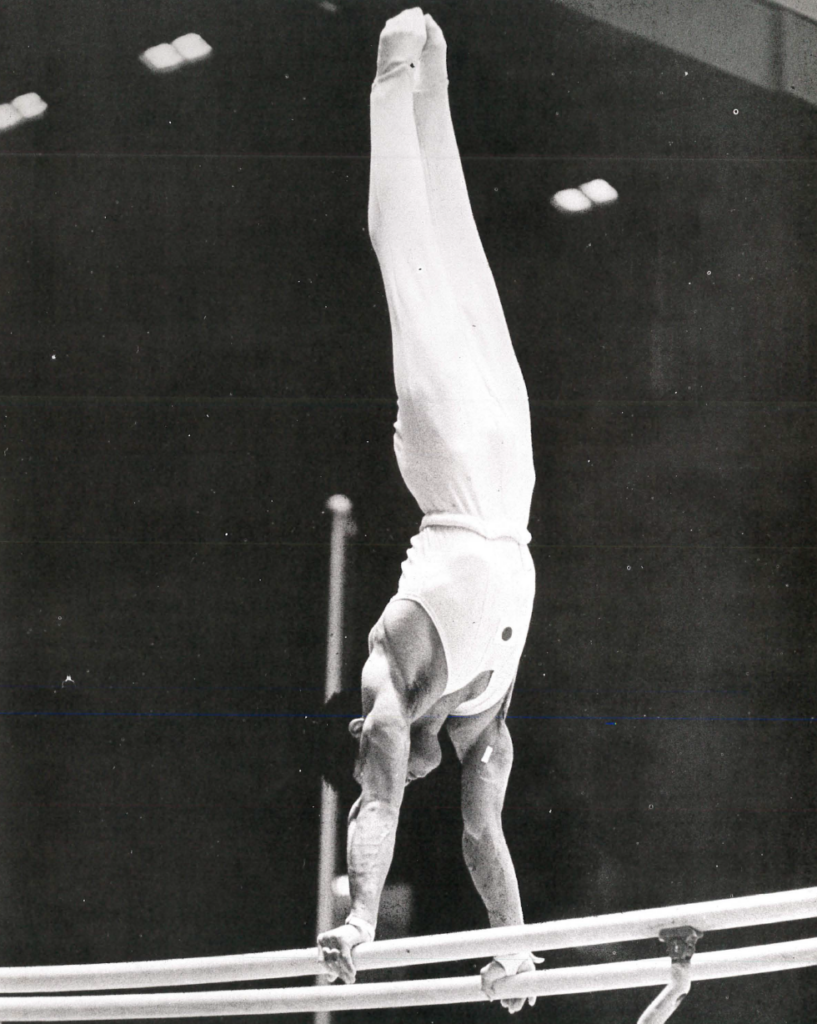
Parallel Bars
| Country | Finals | COA | Total | |
| 1. Endo Yukio | JPN | 9.90 | 9.775 | 19.675 |
| 2. Tsurumi Shuji | JPN | 9.70 | 9.750 | 19.450 |
| 3. Menichelli, Franco | ITA | 9.70 | 9.650 | 19.350 |
| 4. Diomidov, Sergei | URS | 9.55 | 9.675 | 19.225 |
| 5. Lisitsky, Viktor | URS | 9.45 | 9.750 | 19.200 |
| 6. Cerar, Miroslav | YUG | 8.70 | 9.750 | 18.450 |
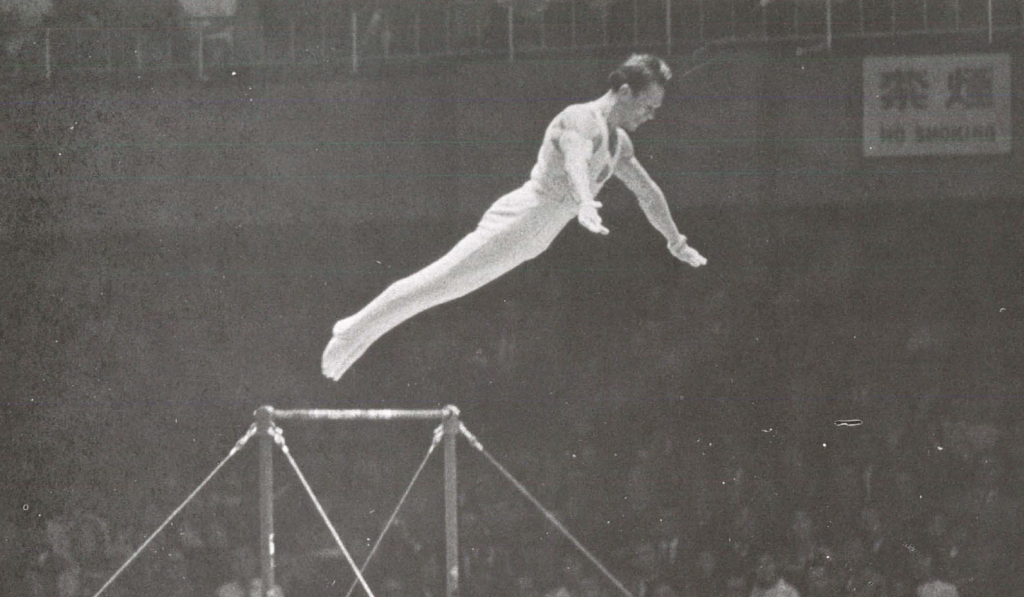
| Country | Finals | COA | Total | |
| 1. Shakhlin, Boris | URS | 9.85 | 9.775 | 19.625 |
| 2. Titov, Yuri | URS | 9.80 | 9.750 | 19.550 |
| 3. Cerar, Miroslav | YUG | 9.85 | 9.650 | 19.500 |
| 4. Lisitsky, Viktor | URS | 9.70 | 9.625 | 19.325 |
| 5. Endo Yukio | JPN | 9.35 | 9.700 | 19.050 |
| 6. Ono Takashi | JPN | 9.30 | 9.700 | 19.000 |
Endo needed a 10 to win gold on high bar but couldn’t pull it off.
Here’s how Banner recounted the event…
Endo needed 10 to win the gold medal after Boris Chalklin received 9.85 with a beautifully executed stock routine and a perfect landing. Endo was obviously “shooting the works” with an ultra-difficult exercise. The crowd was on edge as the dismount approached. Endo was a silver medalist until the dismount. His hecht over the bar with a full twist was a heart stopper and the 10 points were getting closer as he hung for a fraction of a second before the twist, then, as his head and shoulders began the twist, it was apparent to experienced eyes that the lower body was not responding and adjustments would have to be made. All were made, every muscle strained to contact the mat with precision and exactness. To no avail! The twist adjustments caused an off balance contact and a deduction great enough to slip Endo below the medal winners.
Modern Gymnast, Jan. 1965
Notice the reference to an “ultra-difficult” exercise.
Again, gymnasts were performing more difficulty than was required, and the Code allowed judges to go easier on gymnasts performing more difficulty than necessary:
An exercise which presents great risks, originality, and difficult connecting parts (transitions) will be less severely judged for small execution faults than the exercise which is lacking in originality, virtuosity, and risk.
This comes into play during the judging controversy and the subsequent discussions about abandoning the 10.0.
Judging Controversy
Here’s the video of Endo’s pommel horse routine. Jump ahead to the 17:05 mark.
You don’t have to be a pommel horse expert to notice that there are three clear mistakes in the routine.
Nor do you need to be a 1964 Code of Points expert to think, “Hmm, my gut says that Endo’s routine definitely shouldn’t score above a 9.0.”
Well, you aren’t alone. Here’s how Larry Banner described the situation:
Yukio Endo was striving for the all-around gold medal but needed some help to take it home. His last exercise on the pommeled horse has been scored by various witnesses from 8.1 to 8.7, and one sideline expert declared that strict adherence to the rules of execution and exercise construction would result in a score of 7.7 to 7.9. Endo’s score: 9.10, giving him the symbol of absolute greatness. It was as though the participating officials had to decide whether or not Endo should win the all-around medal.
Modern Gymnast, Jan. 1965
The Russian team filed a protest.
The Russians filed an official protest, but as Meshikov, the Russian team coach, explained, not to fight for a score change-merely to demonstrate concern and awareness.
Modern Gymnast, Jan. 1965
Don’t you wish that you could still protest other teams’ scores?
Banner wasn’t a disgruntled American who was jealous of a superior gymnast. As we’ll see in our next post, the judging of Endo’s routine outraged many gymnastics fans from around the world, and once again, the 10.0 system was called into question.
It should be noted that there was a Japanese judge on the judging panel for pommel horse.
On that note, here were the judging assignments for the competition:
Floor Exercise
- Superior Judge: Kondo (JPN)
- Bauch (GER)
- Brown (AUS)
- Jolantie (FIN)
- Lavrouchenko (URS)
- Timer: Ikeda (JPN)
Pommel Horse
- Superior Judge: Ivancevic (YUG)
- Uesako (JPN)
- Bettyna (POL)
- Wilderoter (USA)
- Kim (KOR)
Rings
- Superior Judge: Lylo (TCH)
- Maloney (USA)
- Stadel (GER)
- Koguchi (JPN)
- Vieru (ROM)
Vault
- Superior Judge: Spieth (GER)
- Karakchianz (URS)
- Widmer (SUI)
- Nabeya (JPN)
- Tanner (FIN)
- Hand Placement: Fukai (JPN)
- Hand Placement: Baba (JPN)
Parallel Bars
- Superior Judge: Lahtinen (FIN)
- Lehmann (SUI)
- Bitsch (FRA)
- Sotorník (TCH)
- Monetti (ITA)
Horizontal Bar
- Superior Judge: Mironov (URS)
- Sárkány (HUN)
- Urbani (ITA)
- Matlocha (TCH)
- Mirtchev (BUL)
(Source: Official Report: The Games of the XVIII Olympiad, Tokyo)
Math Gym Nerdery
This doesn’t really fit with the rest of the post, but I know that at least 3 people in the world will find this interesting, so I’m tacking it on to the end.
Being a math nerd and a gym nerd has always been a match made in heaven. Check out the statistical analyses of the Olympics that were printed in the Modern Gymnast.